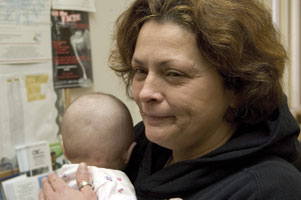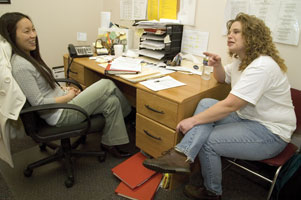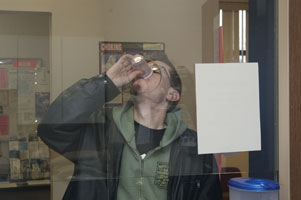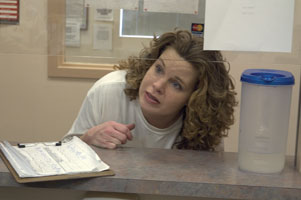|
May/June 2007 Issue Medicating With Methadone: Drug Dealing or Humane Treatment?
But Liz Campbell, MSW, MPA, LGSW, disagrees. She is the clinical supervisor of the Clarksburg Treatment Center (CKCT) in Clarksburg, WV. The center is owned by CRC Health Group, a for-profit company that operates six similar centers in West Virginia. “I’ve worked in a nonprofit before and watched people lose their jobs because there wasn’t enough money,” Campbell says. “I don’t look at it like we’re doing something wrong just because it’s for profit. It means that we can keep providing good services to our patients.” Some misconceptions about opioid treatment focus on the idea of “addiction substitution,” says Campbell. She says using methadone to treat opioid addiction is similar to using insulin to treat a diabetic condition; it is a medication to help with a disease.
In the CKCT detoxification program, a person aims to be methadone-free after six months. With the maintenance to abstinence program, two years of treatment concludes with six months of methadone-free counseling. “When they’re ready, we want them to start decreasing their dose,” Campbell says. According to the National Guidelines Clearinghouse, a federal Web site that details best practices, both continued medical-assisted treatment with opioids and tapering are legitimate goals and commendable accomplishments. The Clearinghouse even cautions treatment providers not to inadvertently create a climate that favors tapering by celebrating patients who progress to tapering while overlooking the success of those who maintain themselves on methadone (2005). Typically, a patient should take methadone for two years before proceeding to tapering.
“When people first come in, medication is the central portion of their treatment because they don’t feel well. We have to get them to feel better before we can work on the cognitive things, like helping them change their behavior,” Campbell says. “But counseling is the biggest part of what we do here. We offer 10 different groups on top of individual counseling. That is where the magic happens.” The CKCT offers methadone and suboxone treatments along with the counseling program. Determining what medicine at what dosage is right for someone is similar to perfecting a recipe, Campbell explains. You add or subtract based on symptoms and patient-described feelings. “Methadone is addictive, and we tell people that right off the bat. Suboxone is less addictive, and that is a selling point to many people,” Campbell says.
“There are a lot of instabilities that go along with addiction in general. A lot of people lose their jobs or have trouble with their families,” Campbell says. “What the methadone or suboxone does is help create that stability. Once people reach a therapeutic dose, they should be able to function as normally as before they started using.” The instability of addiction is now just a memory for Stephanie, a recovering addict and patient of the treatment center. “I was putting my addiction before my son, and I couldn’t even see it at the time,” she says. “Me and my son would go to the store, and he would want a $10 or $15 toy. But my new math was, ‘That’s three pills I could buy.’” Stephanie says her addiction to pain medication began with a legitimate prescription given after an injury. Her doctor prescribed Lortab, and she refilled the prescription for almost one year. Stephanie says it wasn’t long before she was addicted and turned to the underground for the pills she could no longer get legally. Stephanie explains how she worked to hide her addiction from everyone, including her mother. She devoted all the extra money she could to her addiction for roughly six years before deciding it was time for a change. “I was taking 15 [10 milligram] pills a day,” Stephanie acknowledges. “I thought of myself first over my son and over my family’s finances. It really got out of hand,” Stephanie says. “I hit rock bottom, then I saw the light at the end of the tunnel. Either it was going to be a train or the clinic here.” After she went to a doctor and was honest about her addiction, Stephanie was given the phone number for the CKCT. She began the outpatient treatment the same week but kept it hidden from her family, similar to how she had hidden her addiction. “I was coming out here for a year until I even confided to her [mother] that I had a problem with the pills,” Stephanie says. “I just broke down and was honest with her.” She says her mother was supportive of her efforts to “get clean.” Feeling ashamed of how her son had not been the highest priority in her life, she also decided to come clean with him. “I just had to be honest with him,” she says. “He was only 8 years old, but he understood.” Stephanie says within the first few days of treatment, the “haze” which defined her addiction had lifted, and she could think clearly again. Within the first two weeks of treatment, she had begun to reclaim her life and was hired for a government job. She attributes her life change to the counseling and methadone treatment she received from the center. “Now, I get my paycheck, and I don’t have to look at it and wonder how much money I can take out for pills,” she says. “It’s just wonderful.” Stephanie is now tapering her methadone dosage. She says she has reduced her intake by one half so far and, by the end of the year, is expected to be off methadone completely. “To see [patients] doing well, maybe with their kids back and working a full-time job, gives me a sense of accomplishment. For social workers, that is where our reward is—seeing other people do well,” Campbell says. “Seeing the rewards and feeling that sense of accomplishment takes a little bit longer, but it’s an emotion that you can’t explain. You just feel good that you’ve helped someone.” — Robert Rizzuto is a senior journalism major at West Virginia University. He reports for West Virginia Public Broadcasting and freelances with several publications throughout the state. — Neal A. Newfield, PhD, ACSW, is an associate professor of social work and a documentary photographer with the division of social work at West Virginia University. Resource National Guidelines Clearinghouse. (2005) Medication-assisted treatment for opioid addiction in opioid treatment programs: Phases of treatment. Substance Abuse and Mental Health Services Administration (U.S.)—Federal Government Agency [U.S.]. |

 Some U.S. citizens, judges, and legislators have described the services provided by for-profit opioid treatment programs as “legalized drug dealing.”
Some U.S. citizens, judges, and legislators have described the services provided by for-profit opioid treatment programs as “legalized drug dealing.” Some West Virginia state legislators have claimed for-profit clinics lack the motivation to taper patients off methadone. Not a problem with her clinic, according to Campbell. She says the CKCT typically does not place time frames on patients but offers different treatment programs with tentative benchmarks for when a person will begin to taper his or her dosage.
Some West Virginia state legislators have claimed for-profit clinics lack the motivation to taper patients off methadone. Not a problem with her clinic, according to Campbell. She says the CKCT typically does not place time frames on patients but offers different treatment programs with tentative benchmarks for when a person will begin to taper his or her dosage. According to Campbell, the treatment center helps an average of 280 to 300 people per month. She, along with a few supervisors, a small nursing staff, and six counselors, ensure that the facility is accomplishing its goal: helping patients get their lives back.
According to Campbell, the treatment center helps an average of 280 to 300 people per month. She, along with a few supervisors, a small nursing staff, and six counselors, ensure that the facility is accomplishing its goal: helping patients get their lives back. She explains that the medical treatment has three specific goals. It aims to prevent narcotic withdrawal, block the effects of narcotics on the body, and weaken or eliminate an individual’s craving.
She explains that the medical treatment has three specific goals. It aims to prevent narcotic withdrawal, block the effects of narcotics on the body, and weaken or eliminate an individual’s craving. 